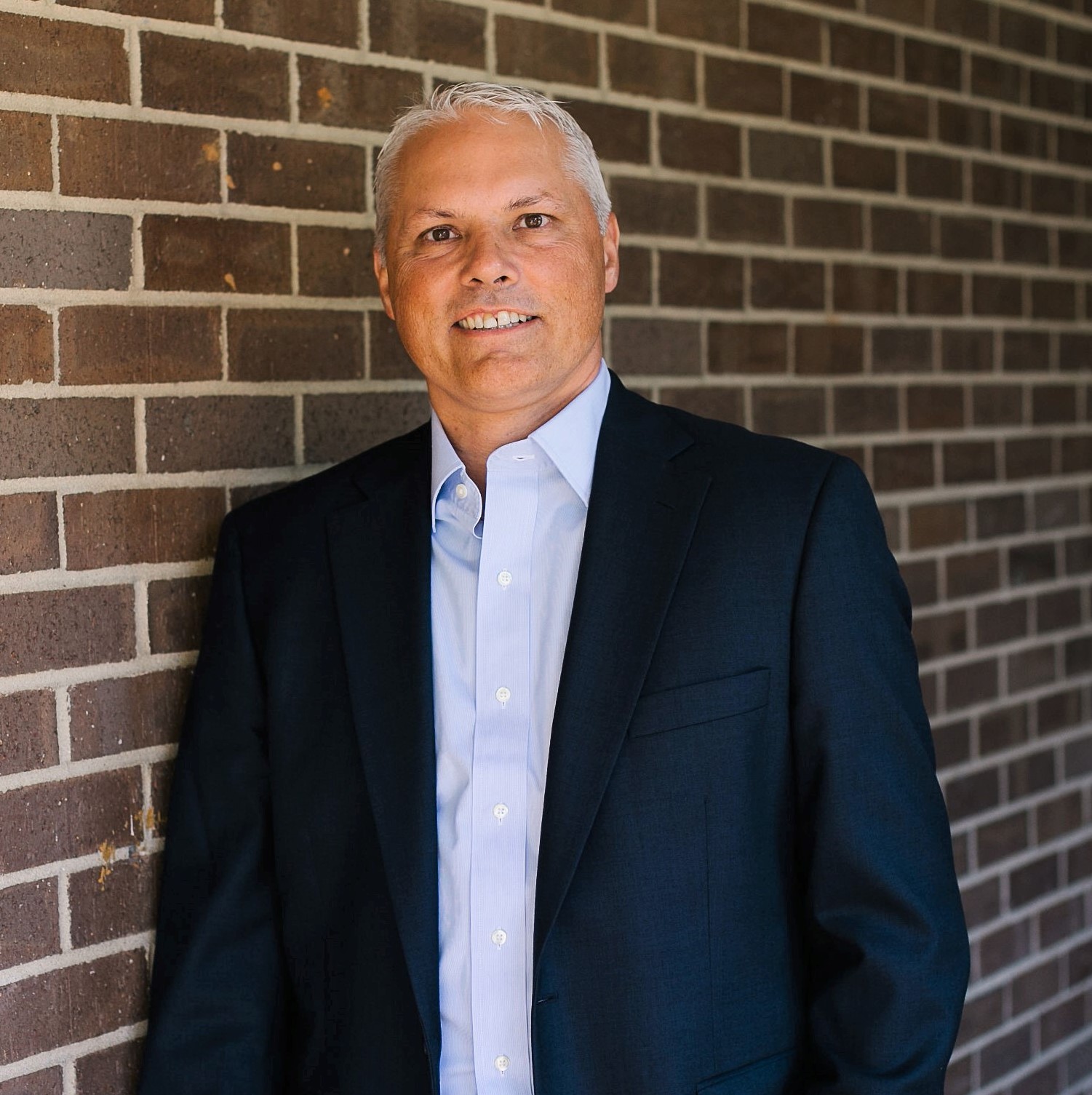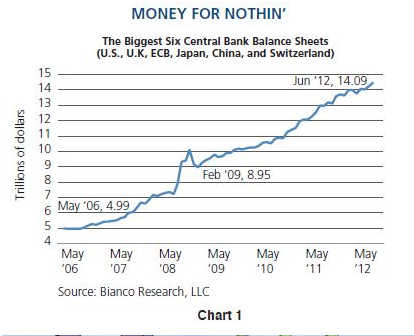Global View Investment Blog
Investment Outlook: Money for Nothin’, Writing Checks for Free
The following is the latest Investment Outlook from Bill Gross, titled “Money for Nothin’, Writing Checks for Free”. The commentary discusses the extraordinary actions that the Federal Reserve is now engaged, as well as other major Central Banks.
From my perspective, the long story-short is that this economic activity is not currently self sustaining. The Federal Government is borrowing and spending $1.2 Trillion per year and the Federal Reserve is loaning them most of that money after creating it from thin air. These actions are holding asset prices (stocks, bonds, metals, and houses) higher than they otherwise would be. This scenario creates many difficult questions: How long can these policies remain in place? What will cause them to end? What is the true level of organic economic activity? What will happen to asset prices if these accommodative policies are interrupted? What will happen to asset prices if they continue indefinitely?
Adam Wiles, Partner & CFP
Money for Nothin’ Writing Checks for Free - Bill Gross – PIMCO
It was Milton Friedman, not Ben Bernanke, who first made reference to dropping money from helicopters in order to prevent deflation. Bernanke’s now famous “helicopter speech” in 2002, however, was no less enthusiastically supportive of the concept. In it, he boldly previewed the almost unimaginable policy solutions that would follow the black swan financial meltdown in 2008: policy rates at zero for an extended period of time; expanding the menu of assets that the Fed buys beyond Treasuries; and of course quantitative easing purchases of an almost unlimited amount should they be needed. These weren’t Bernanke innovations – nor was the term QE. Many of them had been applied by policy authorities in the late 1930s and ‘40s as well as Japan in recent years. Yet the then Fed Governor’s rather blatant support of monetary policy to come should have been a signal to investors that he would be willing to pilot a helicopter should the takeoff be necessary. “Like gold,” he said, “U.S. dollars have value only to the extent that they are strictly limited in supply. But the U.S. government has a technology, called a printing press (or, today, its electronic equivalent), that allows it to produce as many U.S. dollars as it wishes at essentially no cost.”
Mr. Bernanke never provided additional clarity as to what he meant by “no cost.” Perhaps he was referring to zero-bound interest rates, although at the time in 2002, 10-year Treasuries were at 4%. Or perhaps he knew something that American citizens, their political representatives, and almost all investors still don’t know: that quantitative easing – the purchase of Treasury and Agency mortgage obligations from the private sector – IS essentially costless in a number of ways. That might strike almost all of us as rather incredible – writing checks for free – but that in effect is what a central bank does. Yet if ordinary citizens and corporations can’t overdraft their accounts without criminal liability, how can the Fed or the European Central Bank or any central bank get away with printing “electronic money” and distributing it via helicopter flyovers in the trillions and trillions of dollars?
Well, the answer is sort of complicated but then it’s sort of simple: They just make it up. When the Fed now writes $85 billion of checks to buy Treasuries and mortgages every month, they really have nothing in the “bank” to back them. Supposedly they own a few billion dollars of “gold certificates” that represent a fairy-tale claim on Ft. Knox’s secret stash, but there’s essentially nothing there but trust. When a primary dealer such as J.P. Morgan or Bank of America sells its Treasuries to the Fed, it gets a “credit” in its account with the Fed, known as “reserves.” It can spend those reserves for something else, but then another bank gets a credit for its reserves and so on and so on. The Fed has told its member banks “Trust me, we will always honor your reserves,” and so the banks do, and corporations and ordinary citizens trust the banks, and “the beat goes on,” as Sonny and Cher sang. $54 trillion of credit in the U.S. financial system based upon trusting a central bank with nothing in the vault to back it up. Amazing!
But the story doesn’t end here. What I have just described is a rather routine textbook explanation of how central and fractional reserve banking works its productive yet potentially destructive magic. What Governor Bernanke may have been referring to with his “essentially free” comment was the fact that the Fed and other central banks such as the Bank of England (BOE) actually rebate the interest they earn on the Treasuries and Gilts that they buy. They give the interest back to the government, and in so doing, the Treasury issues debt for free. Theoretically it’s the profits of the Fed that are returned to the Treasury, but the profits are the interest on the $2.5 trillion worth of Treasuries and mortgages that they have purchased from the market. The current annual remit amounts to nearly $100 billion, an amount that permits the Treasury to reduce its deficit by a like amount. When the Fed buys $1 trillion worth of Treasuries and mortgages annually, as it is now doing, it effectively is financing 80% of the deficit for free.
The BOE and other central banks work in a similar fashion. British Chancellor of the Exchequer (equivalent to our Treasury Secretary) George Osborne wrote a letter to Mervyn King, Governor of the BOE (equivalent to our Fed Chairman) in November. “Transferring the net income from the APF [Asset Purchase Facility – Britain’s QE] will allow the Government to manage its cash more efficiently, and should lead to debt interest savings to central government in the short-term.” Savings indeed! The Exchequer issues gilts, the BOE’s QE program buys them and then remits the interest back to the Exchequer. As shown in Chart 1, the world’s six largest central banks have collectively issued six trillion dollars’ worth of checks since the beginning of 2009 in order to stem private sector delevering. Treasury credit is being backed with central bank credit with the interest then remitted to its issuer. Should interest rates rise and losses accrue to the Fed’s portfolio, they record it as an accounting liability owed to the Treasury, which need never be paid back. This is about as good as it can get folks. Money for nothing. Debt for free.
Investors and ordinary citizens might wonder then, why the fuss over the fiscal cliff and the increasing amount of debt/GDP that current deficits portend? Why the austerity push in the U.K., and why the possibly exaggerated concern by U.S. Republicans over spending and entitlements? If a country can issue debt, have its central bank buy it, and then return the interest, what’s to worry? Alfred E. Neuman for President (or House Speaker!).
Well ultimately government financing schemes such as today’s QE’s or England’s early 1700s South Sea Bubble end badly. At the time Sir Isaac Newton was asked about the apparent success of the government’s plan and he responded by saying that “I can calculate the movement of the stars but not the madness of men.” The madness he referred to was the rather blatant acceptance by government and its citizen investors, that they had discovered the key to perpetual prosperity: “essentially costless” debt financing. The plan’s originator, Scotsman John Law, could not have conceived of helicopters like Ben Bernanke did 300 years later, but the concept was the same: writing checks for free.
Yet the common sense of John Law – and likewise that of Ben Bernanke – must have known that only air comes for free and is “essentially costless.” The future price tag of printing six trillion dollars’ worth of checks comes in the form of inflation and devaluation of currencies either relative to each other, or to commodities in less limitless supply such as oil or gold. To date, central banks have been willing to accept that cost – nay – have even encouraged it. The Fed is now comfortable with 2.5% inflation for at least 1–2 years and the Bank of Japan seems willing to up their targeted objective to something above as opposed to below ground zero. But in the process, zero-bound yields and their QE check writing may have distorted market prices, and in the process the flow as well as the existing stock of credit. Capital vs. labor; bonds/stocks vs. cash; lenders vs. borrowers; surplus vs. deficit nations; rich vs. the poor: these are the secular anomalies and mismatches perpetuated by unlimited check writing that now threaten future stability.
Ben Bernanke has publically acknowledged these growing disparities. “We are quite aware,” he said in November 2011, “that very low interest rates, particularly for a protracted period, do have costs for a lot of people… I think the response is, though, that there is a greater good here, which is the health and recovery of the U.S. economy... I mean, ultimately, if you want to earn money on your investments, you have to invest in an economy which is growing.”
That growth now is to be measured each and every employment Friday via an unemployment rate thermostat set at 6.5%. We at PIMCO would not argue with that objective. Yet we would caution, as Bernanke himself has cautioned, that there are negative consequences and that when central banks enter the cave of quantitative easing and “essentially costless” electronic printing of money, there may be dragons.
Investment conclusions
Investors should be alert to the longterm inflationary thrust of such check writing.While they are not likely to breathe fire in 2013, the inflationary dragons lurk in the “out” years towards which long-term bond yields are measured. You should avoid them and confine your maturities and bond durations to short/intermediate targets supported by Fed policies. In addition, be aware of PIMCO’s continued concerns about the increasing ineffectiveness of quantitative easing with regards to the real economy. Zero-bound interest rates, QE maneuvering, and “essentially costless” check writing destroy financial business models and stunt investment decisions which offer increasingly lower ROIs and ROEs. Purchases of “paper” shares as opposed to investments in tangible productive investment assets become the likely preferred corporate choice. Those purchases may be initially supportive of stock prices but ultimately constraining of true wealth creation and real economic growth. At some future point, risk assets – stocks, corporate and high yield bonds – must recognize the difference. Bernanke’s dreams of economic revival, which would then lead to the day that investors can earn higher returns, may be an unattainable theoretical hope, in contrast to a future reality. Japan we are not, nor is Euroland or the U.K. – just yet. But “costless” check writing does indeed have a cost and checks cannot perpetually be written for free.
by William H. Gross
Managing Director

Written by Adam Wiles
Adam is a Partner at Global View. Adam’s primary focus is on investment strategy, retirement planning, risk management, and new client identification. He has extensive experience and training in identifying client’s needs and explaining the solutions that meet those needs. He worked with Merrill Lynch for 2 years prior to joining Global View. Prior to Merrill Lynch, Adam worked 10 years, in several trading capacities, within the Commodity Lumber business.
Are you on track for the future you want?
Schedule a free, no-strings-attached portfolio review today.
Talk With Us






